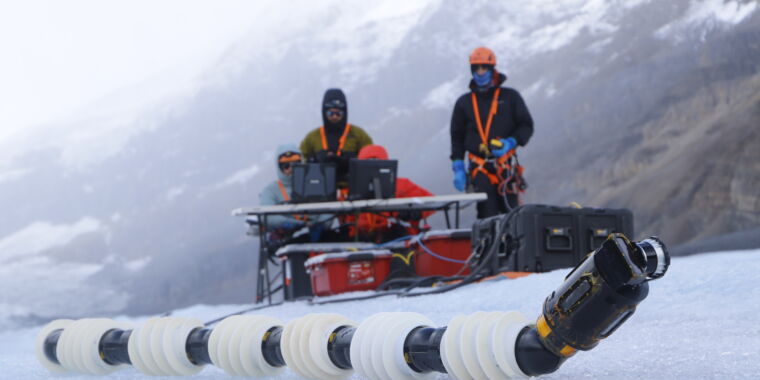Icy ocean worlds like Europa or Enceladus are some of the most promising locations for finding extra-terrestrial life in the Solar System because they host liquid water. But to determine if there is something lurking in their alien oceans, we need to get past ice cover that can be dozens of kilometers thick. Any robots we send through the ice would have to do most of the job on their own because communication with these moons takes as much as 155 minutes.
Researchers working on NASA Jet Propulsion Laboratory’s technology development project called Exobiology Extant Life Surveyor (EELS) might have a solution to both those problems. It involves using an AI-guided space snake robot. And they actually built one.
Geysers on Enceladus
The most popular idea to get through the ice sheet on Enceladus or Europa so far has been thermal drilling, a technique used for researching glaciers on Earth. It involves a hot drill that simply melts its way through the ice. “Lots of people work on different thermal drilling approaches, but they all have a challenge of sediment accumulation, which impacts the amount of energy needed to make significant progress through the ice sheet,” says Matthew Glinder, the hardware lead of the EELS project.
So, instead of drilling new holes in ice, the EELS team focuses on using ones that are already there. The Cassini mission discovered geyser-like jets shooting water into space from vents in the ice cover near Enceladus’ south pole. “The concept was you’d have a lander to land near a vent and the robot would move on the surface and down into the vent, search the vent, and through the vent go further down into the ocean”, says Matthew Robinson, the EELS project manager.
The problem was that the best Cassini images of the area where that lander would need to touch down have a resolution of roughly 6 meters per pixel, meaning major obstacles to landing could be undetected. To make things worse, those close-up images were monocular, which meant we could not properly figure out the topography. “Look at Mars. First we sent an orbiter. Then we sent a lander. Then we sent a small robot. And then we sent a big robot. This paradigm of exploration allowed us to get very detailed information about the terrain,” says Rohan Thakker, the EELS autonomy lead. “But it takes between seven to 11 years to get to Enceladus. If we followed the same paradigm, it would take a century,” he adds.
All-terrain snakes
To deal with unknown terrain, the EELS team built a robot that could go through almost anything—a versatile, bio-inspired, snake-like design about 4.4 meters long and 35 centimeters in diameter. It weighs about 100 kilograms (on Earth, at least). It’s made of 10 mostly identical segments. “Each of those segments share a combination of shape actuation and screw actuation that rotates the screws fitted on the exterior of the segments to propel the robot through its environment,” explains Glinder. By using those two types of actuators, the robot can move using what the team calls “skin propulsion,” which relies on the rotation of screws, or using one of various shape-based movements that rely on shape actuators. “Sidewinding is one of those gaits where you are just pressing the robot against the environment,” Glinder says.

The standard sensor suite is fitted on the head and includes a set of stereo cameras providing a 360-degree viewing angle. There are also inertial measuring units (IMUs) that use gyroscopes to estimate the robot’s position, and lidar sensors. But it also has a sense of touch. “We are going to have torque force sensors in each segment. This way we will have direct torque plus direct force sensing at each joint,” explains Robinson. All this is supposed to let the EELS robot safely climb up and down Enceladus’ vents, hold in place in case of eruptions by pressing itself against the walls, and even navigate by touch alone if cameras and lidar don’t work.
But perhaps the most challenging part of building the EELS robot was its brain.

